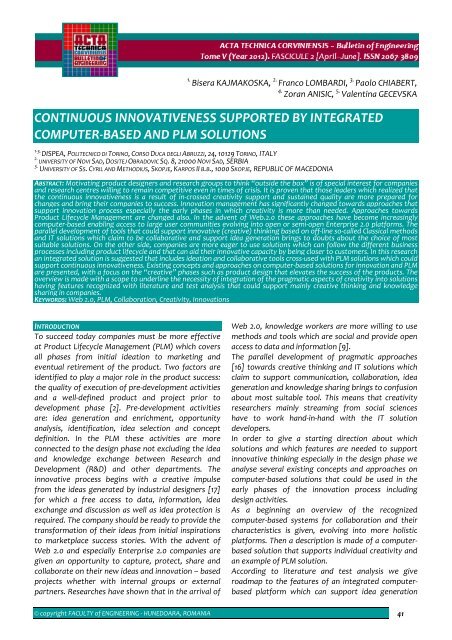Editorial & Advisory Board - Acta Technica Corviniensis
Editorial & Advisory Board - Acta Technica Corviniensis
Editorial & Advisory Board - Acta Technica Corviniensis
Create successful ePaper yourself
Turn your PDF publications into a flip-book with our unique Google optimized e-Paper software.
1.<br />
Bisera KAJMAKOSKA, 2. Franco LOMBARDI, 3. Paolo CHIABERT,<br />
4.<br />
Zoran ANISIC, 5. Valentina GECEVSKA<br />
CONTINUOUS INNOVATIVENESS SUPPORTED BY INTEGRATED<br />
COMPUTER‐BASED AND PLM SOLUTIONS<br />
1‐3.<br />
DISPEA, POLITECNICO DI TORINO, CORSO DUCA DEGLI ABRUZZI, 24, 10129 TORINO, ITALY<br />
2.<br />
UNIVERSITY OF NOVI SAD, DOSITEJ OBRADOVIC SQ. 8, 21000 NOVI SAD, SERBIA<br />
3. UNIVERSITY OF SS. CYRIL AND METHODIUS, SKOPJE, KARPOS II B.B., 1000 SKOPJE, REPUBLIC OF MACEDONIA<br />
ABSTRACT: Motivating product designers and research groups to think “outside the box” is of special interest for companies<br />
and research centres willing to remain competitive even in times of crisis. It is proven that those leaders which realized that<br />
the continuous innovativeness is a result of in‐crossed creativity support and sustained quality are more prepared for<br />
changes and bring their companies to success. Innovation management has significantly changed towards approaches that<br />
support innovation process especially the early phases in which creativity is more than needed. Approaches towards<br />
Product Lifecycle Management are changed also. In the advent of Web.2.0 these approaches have become increasingly<br />
computer‐based enabling access to large user communities evolving into open or semi‐open Enterprise 2.0 platforms. The<br />
parallel development of tools that could support innovative (creative) thinking based on off‐line so‐called Classical methods<br />
and IT solutions which claim to be collaborative and support idea generation brings to doubts about the choice of most<br />
suitable solutions. On the other side, companies are more eager to use solutions which can follow the different business<br />
processes including product lifecycle and that can aid their innovative capacity by being closer to customers. In this research<br />
an integrated solution is suggested that includes ideation and collaborative tools cross‐used with PLM solutions which could<br />
support continuous innovativeness. Existing concepts and approaches on computer‐based solutions for innovation and PLM<br />
are presented, with a focus on the “creative” phases such as product design that elevates the success of the products. The<br />
overview is made with a scope to underline the necessity of integration of the pragmatic aspects of creativity into solutions<br />
having features recognized with literature and test analysis that could support mainly creative thinking and knowledge<br />
sharing in companies.<br />
KEYWORDS: Web 2.0, PLM, Collaboration, Creativity, Innovations<br />
INTRODUCTION<br />
To succeed today companies must be more effective<br />
at Product Lifecycle Management (PLM) which covers<br />
all phases from initial ideation to marketing and<br />
eventual retirement of the product. Two factors are<br />
identified to play a major role in the product success:<br />
the quality of execution of pre‐development activities<br />
and a well‐defined product and project prior to<br />
development phase [2]. Pre‐development activities<br />
are: idea generation and enrichment, opportunity<br />
analysis, identification, idea selection and concept<br />
definition. In the PLM these activities are more<br />
connected to the design phase not excluding the idea<br />
and knowledge exchange between Research and<br />
Development (R&D) and other departments. The<br />
innovative process begins with a creative impulse<br />
from the ideas generated by industrial designers [17]<br />
for which a free access to data, information, idea<br />
exchange and discussion as well as idea protection is<br />
required. The company should be ready to provide the<br />
transformation of their ideas from initial inspirations<br />
to marketplace success stories. With the advent of<br />
Web 2.0 and especially Enterprise 2.0 companies are<br />
given an opportunity to capture, protect, share and<br />
collaborate on their new ideas and innovation – based<br />
projects whether with internal groups or external<br />
partners. Researches have shown that in the arrival of<br />
Web 2.0, knowledge workers are more willing to use<br />
methods and tools which are social and provide open<br />
access to data and information [9].<br />
The parallel development of pragmatic approaches<br />
[16] towards creative thinking and IT solutions which<br />
claim to support communication, collaboration, idea<br />
generation and knowledge sharing brings to confusion<br />
about most suitable tool. This means that creativity<br />
researchers mainly streaming from social sciences<br />
have to work hand‐in‐hand with the IT solution<br />
developers.<br />
In order to give a starting direction about which<br />
solutions and which features are needed to support<br />
innovative thinking especially in the design phase we<br />
analyse several existing concepts and approaches on<br />
computer‐based solutions that could be used in the<br />
early phases of the innovation process including<br />
design activities.<br />
As a beginning an overview of the recognized<br />
computer‐based systems for collaboration and their<br />
characteristics is given, evolving into more holistic<br />
platforms. Then a description is made of a computerbased<br />
solution that supports individual creativity and<br />
an example of PLM solution.<br />
According to literature and test analysis we give<br />
roadmap to the features of an integrated computerbased<br />
platform which can support idea generation<br />
© copyright FACULTY of ENGINEERING ‐ HUNEDOARA, ROMANIA 41

















